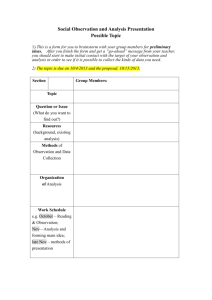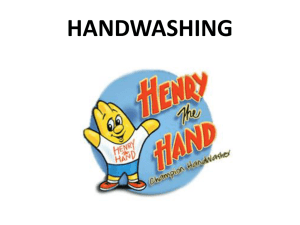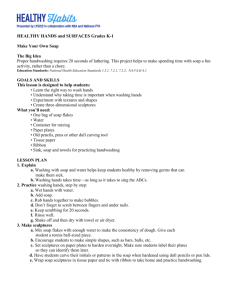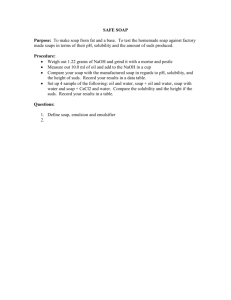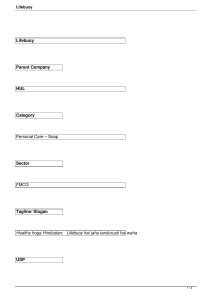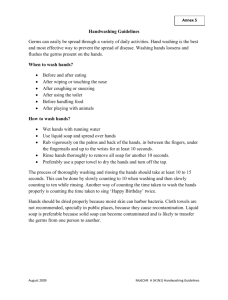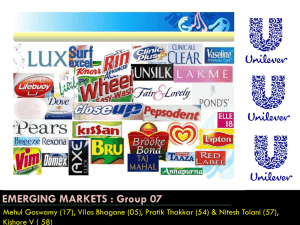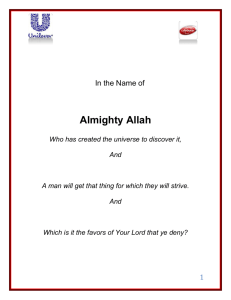Lifebuoy promotes handwashing with soap to improve
advertisement
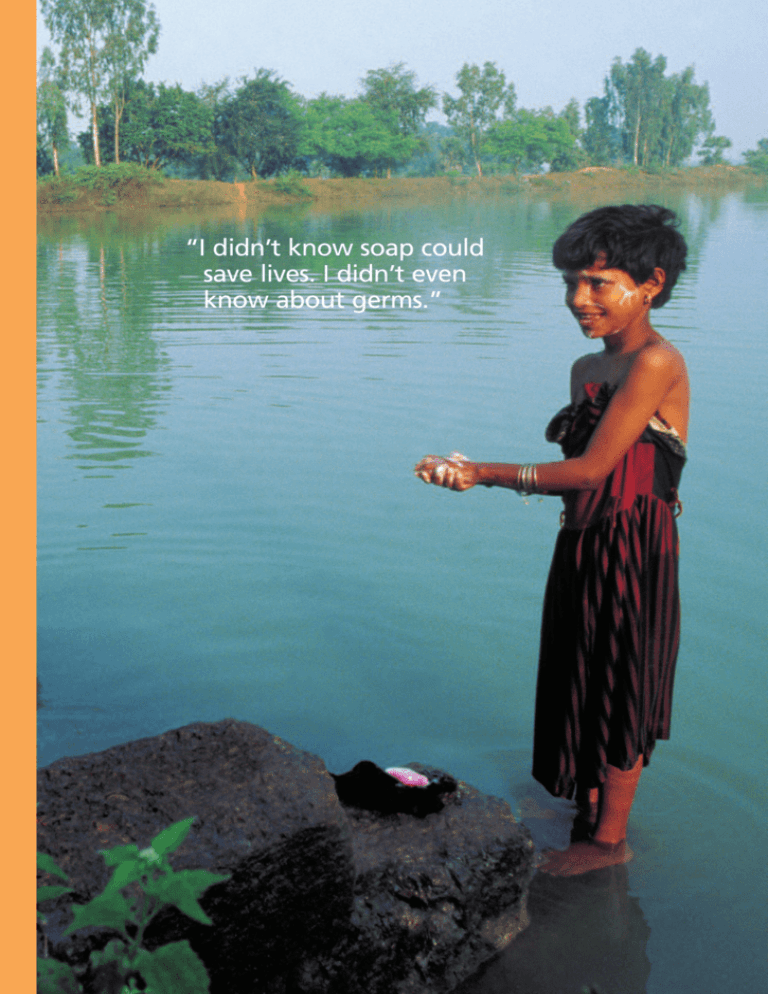
“I didn’t know soap could save lives. I didn’t even know about germs.” Julie (centre) and school friends tour their village with Swasthya Chetna banners to tell everyone about the importance of handwashing with soap. Diarrhoea causes over three million deaths a year. Handwashing with soap and water can reduce diarrhoeal diseases by up to 48% J ulie Sahoo is a schoolgirl from Gangijoodi, a small village 130 kilometres north of Bhubaneswar, the capital of Orissa in East India. Gangijoodi is a poor ricefarming community whose families live off the land, draw their water from wells and live in mud houses that lack basic sanitation. Julie and her friends are only too aware of the misery diarrhoeal diseases can cause. She has so far been spared illness but some of her classmates have not been so lucky. Diarrhoea causes over three million deaths a year worldwide, mostly among children under five years old. To put that into perspective, that is the equivalent of one child dying every ten seconds, or a jumbo jet full of children crashing every hour. Deaths from diarrhoeal diseases represent about a third of all child deaths under the age of five in developing countries. Many more contract eye and skin infections and other conditions that are exacerbated by poor hygiene and malnutrition. In India a child succumbs to diarrhoea every 30 seconds. Yet a World Bank study estimates that handwashing with soap and water can reduce diarrhoeal diseases by up to 48%, preventing over one and a half million children from dying each year. Unilever is one of the world’s major soap manufacturers, with brands such as Lifebuoy, Lux and Dove. The company is no stranger to the lifeprotecting potential handwashing with soap can have on poor communities. Soap was the product on which Lever Brothers, one of Unilever’s two founding companies, was built. The widespread availability of good quality, low-cost, branded soap did much to improve levels of hygiene in nineteenth-century Britain. Today it has the potential to do the same in other countries. Unilever products have been sold in India since 1888 through Hindustan Lever. Lifebuoy is Unilever’s biggest brand in India and the country’s most popular soap. With a sizeable share of the Indian soap market, the company could simply focus its attention on persuading the millions of Indians who currently use soap made by its competitors to switch to Lifebuoy. For Unilever to build its business in India over the long term, though, it must attract new consumers, including the estimated 70 million people who never use soap. Debi Prasad Sahoo, a boy from Julie’s school, in the starring role of the Lifebuoy hero in the Swasthya Diwas show. This is no easy challenge. Over 70% of India’s one billion population live in rural areas not reached by television, radio or newspapers. If that were not challenge enough, illiteracy is widespread and there are deep-rooted beliefs about cleanliness that have to be addressed, such as the widely held belief that if hands look clean, they are clean. W hile Unilever has supported hygiene education programmes in India for many years, in 2002 the Lifebuoy brand team decided that, to have any real impact on reducing diarrhoeal disease, something bigger was needed. Much bigger. It was decided to create a new programme with the bold objective of educating 200 million Indians – 20 per cent of the population - to wash their hands with soap after defecating and to achieve this goal within five years. The campaign, called Swasthya Chetna, meaning ‘Health Awakening’, is the single largest rural health and hygiene education programme ever undertaken in India. To ensure this initiative has a sustainable impact, the Lifebuoy team worked with advisers to develop a multistage programme, designed to involve and educate whole rural communities. After seeking permission from village elders, the Swasthya Chetna teams, consisting of a health development officer and an assistant, visit village schools to teach children about germs and the importance of handwashing with soap. To drive the message home, children are invited to take part in a ‘glowgerm’ demonstration. This involves applying a white powder to the palms of hands, then washing with water only. Hands are then held under an ultra-violet light and the powder glows where dirt remains, showing that handwashing without soap is not enough. The children then repeat the process, this time using soap, only to discover the UV light shows no trace of the powder – a simple but highly effective demonstration. Some weeks later the school puts on a Swasthya Diwas (‘Day’) show for parents, village elders and the community, acting out sketches and songs that extol the virtues of handwashing with soap. In the third phase, the Swasthya Chetna team visits every house in the village, inviting mothers of young children to attend a health education session at which the handwashing message is reinforced and local health workers give children a height and weight check-up. The whole process takes two to three years to ensure handwashing with soap becomes a habit. The next phase involves recruiting schoolchildren, parents and other villagers as volunteers to start up health clubs that, in turn, organise events such as community bathing at the pond villagers use for washing. The whole process, from initial contact to self-managed health club, takes two to three years. While this represents a significant time investment, it is felt this is essential to ensure the handwashing habit becomes part of everyday life. While Hindustan Lever has committed to funding Swasthya Chetna for five years at a cost of €4.5 million (US$ 5.4 million), the company has already started to see a return on its investment. In 2003-4 sales of Lifebuoy grew by 20%, with particularly strong sales in the eight states where the programme operates. To help people on low incomes afford to buy soap, an 18 gram bar of Lifebuoy soap has been introduced, enough for one person to wash their hands once a day for 10 weeks. This sells for two rupees, equivalent to the price of four cups of tea or enough wheat for a meal for one person. It is too soon to say what the impact has been on community health or the programme’s long-term sustainability, but the campaign has prompted a lot of media interest in India and discussions are taking place with the Indian government at national level about extending the programme to other states and beyond Lifebuoy’s initial five-year commitment. “This is not philanthropy. It is marketing with social benefits.” The Swasthya Chetna programme started in 2002 in the eight Indian states where deaths from diarrhoeal diseases are highest and soap sales are lowest. In its first year 9,000 villages were visited by 150 teams of outreach workers speaking seven dialects and with leaflets and posters printed in four languages. In 2003, another 9,000 villages were added, including Gangijoodi, and in 2004 the emphasis was on introducing new phases to these 18,000 villages. By the end of 2004 the campaign had reached 70 million people, including 20 million children at a cost to Hindustan Lever of €2.25 million (US$ 2.7 million). “Swasthya Chetna is not about philanthropy. It’s a marketing programme with social benefits”, explains Hindustan Lever Lifebuoy Brand Manager HarpreetSingh Tibb. “We recognise that the health of our business is totally interconnected with the health of the communities we serve and if we are to grow sales of our brand, we have to increase the number of people who use soap”. The Swasthya Diwas is an important event in Gangijoodi, attended by the whole village. Swasthya Chetna has also generated interest in other parts of Unilever. Unilever Bangladesh has adopted the Indian model for the past two years and in 2004 close to 3,100 villages had been visited. But perhaps the final word on the programme’s impact should go to Julie. “Before Swasthya Chetna came to my school I didn’t know about germs or that diseases can be prevented by washing hands with soap. Now I wash with soap whenever I can and my friends and I are telling everyone about hidden germs and how soap can help you stay well”. Photographs Peter Jordan Communal washing with soap has become a new ritual for the men of Gangijoodi who wash in a separate pond from the women. U nilever believes that one of the best and most sustainable ways it can help to address global social and environmental concerns is through the very business of doing business in a socially aware and responsible manner. This is one in a series of occasional articles called Global Challenges – Local Actions that looks at how Unilever companies are tackling global social and environmental concerns by working in partnership with local, national and international agencies, governments, business organisations and NGOs. If you would like to know more about Hindustan Lever see www.hll.com. For more about Unilever’s social and environmental activities, please visit www.unilever.com/ ourvalues/environmentandsociety. There you will find copies of our latest social and environmental reports and copies of previous articles in this series. Subjects of other articles include: Global Challenges – Local Actions – Micronutrient deficiency in Africa – River pollution in Indonesia – Climate change/refrigeration in Europe – Rural micro-entrepreneurs in India – Sustainable fishing off Africa We would like to hear from you. If you have any questions about this publication or any other aspect of Unilever’s environmental and social policies, please contact: csrcomment@unilever.com Cover picture: Julie Sahoo washes her hands with Lifebuoy soap at the pond villagers use for washing. Or write to: Corporate Relations Unilever PLC PO Box 68 London EC4P 4BQ United Kingdom Corporate Relations Unilever N.V. PO Box 760 3000 DK Rotterdam The Netherlands
